SRH-840A
back to Shure
back to measurements
home
Published: Feb-04-2024
NO SMOOTHING is applied to the shown plots. Most measurement sites have some smoothing applied which ‘irons flat’ sharp peaks and ‘wiggles’. I do not use smoothing because some info about sound quality is lost when plots are smoothed.
Aside from a small correction of the microphone itself also some correction in the lowest frequencies is applied to the plots to compensate for the perceived loss of bass when using headphones. This is described HERE in more detail.
A ‘horizontal‘ frequency response curve on the shown frequency response plots on this website thus indicates a perceived ‘flat’ tonal signature.
ALL measurements are made with a good SEAL on a flatbed measurement rig.
The shape of your head, bone structure, pad size, pad ‘softness, (compliance), hair or no hair and or wearing glasses may (drastically) change the frequency response of some headphones, so… your personal experience may differ substantially from these plots.
Frequency response (tonal balance) is the most sound-determining aspect of headphones. A horizontal line shows audible neutral response in the plots on this website. Deviations in different severity at different frequency bands have an effect on the sound character.
The bigger the deviation the stronger the effect.
Below an aid to help determining the sound character of headphones with relation to the frequency response.

Shure SRH-840A
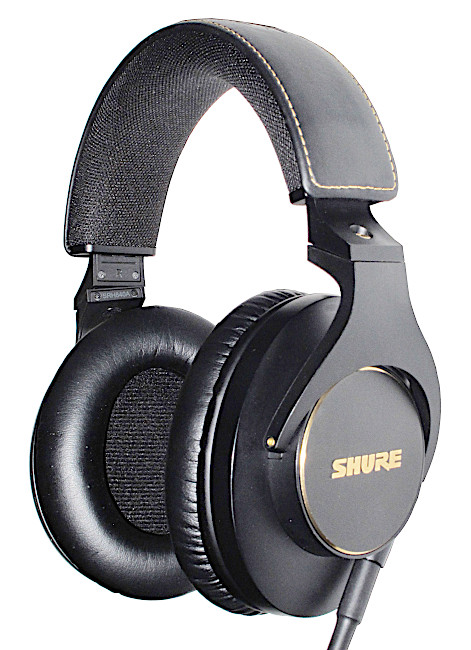
The Shure SRH-840A is a closed over-ear headphone. It is available in black with gold accents. It was launched in 2022 and replaced its predecessor the SRH-840. The price range varies between € 140.- and € 170.- depending on the seller.
The build quality is improved over the old version. Much better quality headband, decent adjusting mechanism. The headband can be extended over 30mm and is easy to adjust. It clicks in 3mm increments. The top material of the headband is made of soft pleather with the Shure logo embossed in it. Orange stitching on the sides make it look nice. Hopefully the used pleather is of higher quality than that of the SRH-840. The material on the bottom side (headrest) is made of cloth. The SRH840 had pleather which started to flake and get ugly quick. The headrest is wide enough to spread the weight. There is regular foam inside.
The cups can fold flat in one direction (folds with the pads upwards). A nice satin black cup with gold color trimming and name. Swivel and tilt is enough to get a good fit on most heads. As this is a closed headphone a good seal is important.
The pad quality improved over that of the SRH-840. It has the same size as the original SRH-840.
These pads have soft memory foam inside giving more comfort and a better seal.
The pads of the SRH940 and SRH1540 also fit.
The SRH-840 comes with a 3m long removable straight cable. It has a gold-plated 2.5mm locking TRS jack on the headphone side which is inserted in the left cup. It exits in a forward angle so it drapes in front of the body. The amplifier side of the cable has a threaded gold-plated 3.5mm TRS jack with a screw-on 6.3mm adapter.
The cable, alas, is microphonic. This means touching the cable and it rubbing against clothes is audible in the left cup.
The sensitivity is quite high (116dB/V @ 1kHz) so it can play impressively loud even from portable sources like phones etc. Even with EU phones with output power restrictions it can play loud.
This headphone is decent in weight (275 gr without the cable) and combined with the low clamping force (2.5N) and soft memory foam pads makes it a comfortable headphone.
specifications:
Type: Over-ear, closed
Usage: Home, Portable, Studio
Isolation: decent
Driver type: dynamic
Pads: replaceable, pleather with memory foam
Inner pad dimensions: Height: 64mm, width: 44 mm, depth: 19mm, oval shaped
Collapsible: no, but folds flat in one direction
Headphone connector: 2.5mm locking (proprietary) TRS jack
Cable: 3m straight in gold plated 3.5mm TRS plug + 6.3 mm adapter
Driver size: ø 40mm (membrane 36mm)
Max. power rating: 0.5W
Max. voltage: 4.1V (12Vpp)
Max. current: 120mA
Max. S.P.L.: 128dB
Impedance: 34Ω (measured)
Sensitivity: 116dB @ 1V
Efficiency: 101dB @ 1mW
Weight: 275 g. (without cable)
Color: black with gold accents
Clamping force: low (2.5N)
Accessories: 3m cable, soft pouch, 6.3mm adapter.
Sound description:
The sound is full/warm, dynamic and ‘clear’ but alas a bit too detailed/sharp.
Stereo imaging is not wide but also not narrow due to the elevated treble.
Bass, depending on the recording can be between bloated/wool-y and full warm.
With well recorded music the bass has ‘power’ but is a bit too ‘fat/bloated’ and bleeding into the mids.
With popular music and older pop/rock recordings the sound is pleasantly warmish.
Bass is not elevated in a ‘Harman type bass lovers’ way but EQ can get you there. This is no problem given the excellent bass extension. Note: a good seal/fit on the head is very important for this aspect.
Mids are full/warm and dynamic and distortion and coloration free.
The treble is not grainy nor of poor quality but certainly over-the-top. At first listen this brings the illusion of a highly detailed sound and fast ‘transients’. But… after a while, and with certain songs, the treble is ‘sharp’ sounding.
Fortunately EQ (filter or easy modification) can remove this sharpness and the sound becomes very balanced and of good quality.
measurements:
Below the frequency response of the SRH-840A (left, right)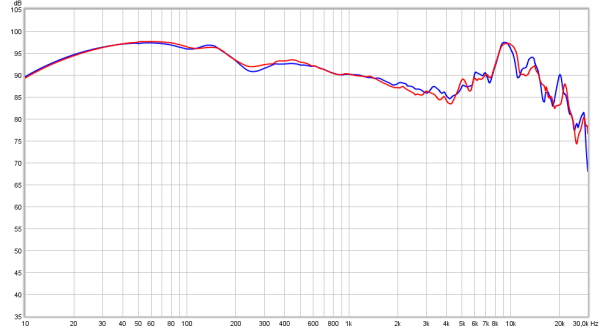 Channel matching is excellent.
Channel matching is excellent.
Bass response extends very low (8Hz -3dB) and is elevated and has some punch but is not ‘tight’ and bloated on recordings with a lot of bass. On bass light recordings the sound is full.
Mids have a slight warmth to it but still have enough clarity.
Above 7kHz is where the trouble starts. There is a huge peak around 9kHz which accentuates the treble but at the same time gives too much ‘sharpness’. Fortunately the treble, despite being too sharp, is still of good quality.
Below the phase response of the SRH-840A (left, right)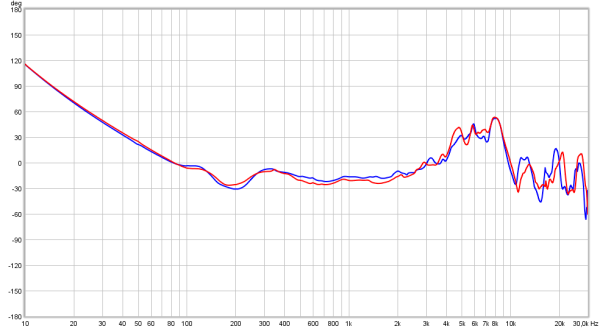 Slow phase shifts are not very audible. Steep changes in a narrow frequency bands may well be audible. Only at 9kHz there is a steep 60° phase shift but otherwise the phase response is fine and as expected.
Slow phase shifts are not very audible. Steep changes in a narrow frequency bands may well be audible. Only at 9kHz there is a steep 60° phase shift but otherwise the phase response is fine and as expected.
Below the Group Delay which can also show potential problem areas. (left, right)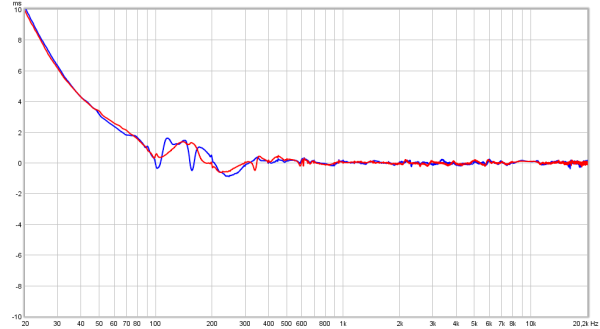
Between 100Hz and 300Hz there is a minimal amount of ‘pad bounce’. Basically a resonance frequency in the pads. Above 300Hz the response is flawless.
Seal
Seal is quite important for closed headphones and this headphone is no exception. Below the effect on the tonal balance is shown when the seal is not perfect. The bass suffers. Perfect seal, seal broken with thick armed glass resting against the skin, seal broken with arms not resting against the skin, seal broken by glasses that are create a few mm gap between the skin and glasses.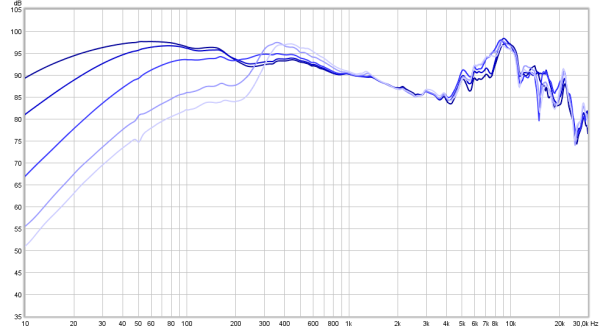 Breaking the seal lowers the amount of bass. A small leakage is already quite audible. When seal is broken a bit more the lows disappear and it starts to sound cuppy. Getting a good seal is very important when low bass is required.
Breaking the seal lowers the amount of bass. A small leakage is already quite audible. When seal is broken a bit more the lows disappear and it starts to sound cuppy. Getting a good seal is very important when low bass is required.
pad compression/aging
When pads wear they usually flatten a bit bringing the drivers closer to the ear. The test below simulates that a little by compressing the pads. It is not exactly the same as pad wear (foam softening and also changing acoustic properties differently than compressing them). Normal thickness, very lightly pressed down (1mm), pads compressed 3mm, pads compressed about 5mm.
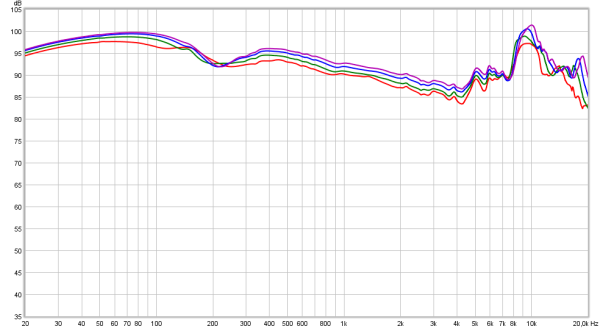 When the pads are compressed the sound becomes a bit louder as the driver is closer to the ear.
When the pads are compressed the sound becomes a bit louder as the driver is closer to the ear.
Below the same measurement but with everything below 1kHz level matched.
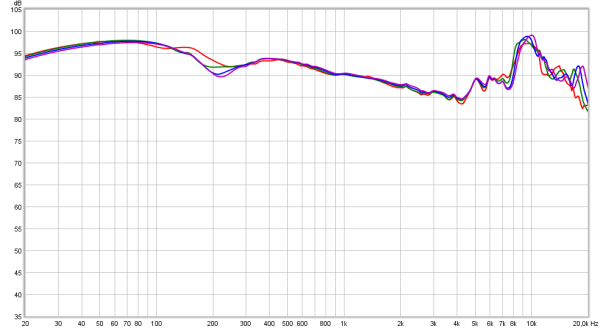 The tonal balance does not change, just the overall level (2.3dB when compressed 5mm) differs.
The tonal balance does not change, just the overall level (2.3dB when compressed 5mm) differs.
Oils from the skin, smoking, wearing time etc all determine when pads need to be changed.
Comparison
Below the original SRH-840 versus the SRH-840A.
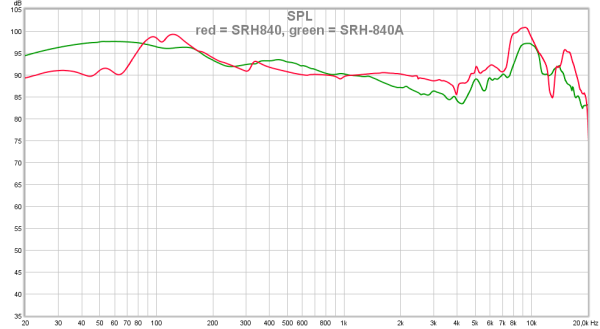 The bass response is quite different. The overall tonality (200Hz to 6kHz) is quite neutral in the SRH-840 and has a warmer (fuller) tilt in the SRH-840A version. Above 6kHz there still is a lot of similarity in these models.
The bass response is quite different. The overall tonality (200Hz to 6kHz) is quite neutral in the SRH-840 and has a warmer (fuller) tilt in the SRH-840A version. Above 6kHz there still is a lot of similarity in these models.
Overall the sound quality of the SRH-840A is a noticeable improvement over the SRH-840.
The SRH-840A is fuller and warmer sounding and a tad less sharp than the SRH-840 which has more clarity and a different bass ‘texture’.
Below the Shure SRH-840A versus some other Shure models (and other) headphones.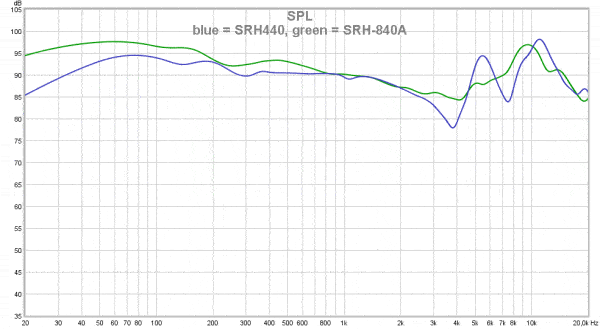
output resistance / damping-factor
As this is a closed dynamic headphone the frequency response can be amplifier output resistance dependent when certain higher output resistance amplifiers are used.
Instead of showing impedance plots, which are hard to ‘read’ when it comes to assessing the tonal balance change in the real world, the Shure SRH-840A is measured via a few different resistance outputs (0.2Ω, 10Ω, 32Ω and 120Ω). On a higher output resistance amplifier the output level will be lower of course due to voltage division. To compensate for this the amplifier is turned up to the same level (12.5dB for 120Ω at 1kHz in this case at max. volume setting). This way the plots are overlaid and it is easier to see how the tonal balance changes. 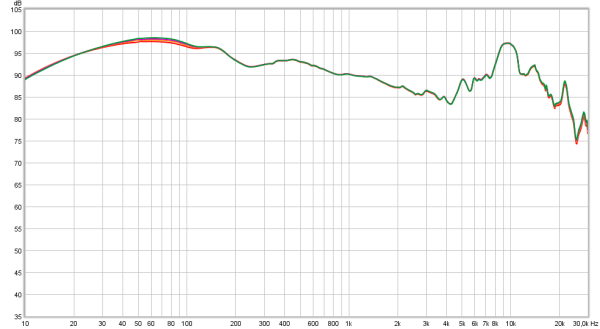 The headphone does not react much to higher output resistances. The resonance frequency is around 60Hz. Output resistance above 120 ohm is not going to add a little extra bass so less suited for usage with AVR and (older) receivers and integrated amps which can have even higher output resistances.
The headphone does not react much to higher output resistances. The resonance frequency is around 60Hz. Output resistance above 120 ohm is not going to add a little extra bass so less suited for usage with AVR and (older) receivers and integrated amps which can have even higher output resistances.
Below the distortion measurements of the SRH-840A (left channel) at 90dB SPL.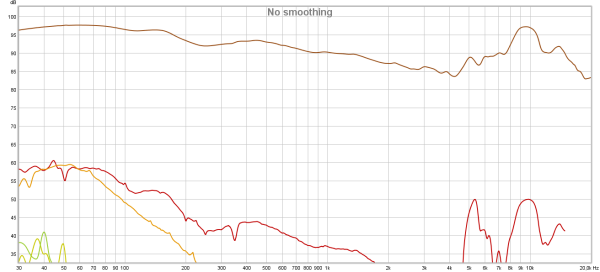
Below the same distortion plot but with the vertical scale in percentages instead of level differences.
Distortion at 90dB SPL (around 1kHz, so around 97dB in the bass) is quite decent (2%) but is also 3rd harmonic distortion which is indicative for ‘compression’.
The 2nd harmonic distortion above 200Hz is probably lower than shown as limits of the test rig are around 0.2%.
Linearity
To see how severe the compression is the SRH-840A is measured 5 times. Once at 60dB, 70dB, 80dB, 90dB and 96dB SPL (at 1kHz). When the traces are overlaid ( on the 90dB trace) and have the same shape then there is no compression visible. Note the 2dB/div scale.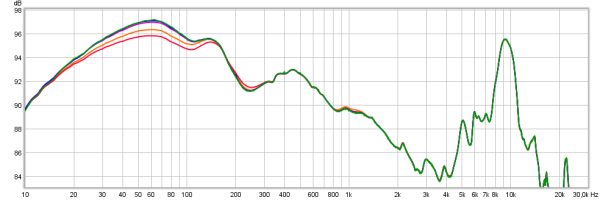 There is some compression below 150Hz starting from around 85dB or so.
There is some compression below 150Hz starting from around 85dB or so.
This means there is little distortion at comfortable levels but when playing louder the distortion increases quickly.
Below the CSD of the SRH-840A (Left and Right are overlaid) Above 4kHz some resonances are showing up. Fortunately the elephant in the room (9kHz) also has a very short decay. The driver seems well damped despite the peak in the frequency response.
Above 4kHz some resonances are showing up. Fortunately the elephant in the room (9kHz) also has a very short decay. The driver seems well damped despite the peak in the frequency response.
Below the spectrum plot of the SRH-840A (left channel).  No alarming resonances are visible.
No alarming resonances are visible.
The step response of the SRH-840A (left, right)
There is some ringing and overshoot in the first 200μs. The rising edge comes up 4dB short compared to the bass and mids showing the warm and bassy character.
The slow and gradual downward slope in the first ms shows the warm sound character.
After 1ms the response hardly drops in level which shows the excellent bass extension.
Pad change
Aside from the mechanical and optical improvements the pads have undergone a change as well.
The outer material of the SRH840A-PADS feels and looks slightly different from the HPAEC840 pads from the SRH-840. The biggest change, however, is inside the pads. The pads from the SRH-840A have memory foam in them where the SRH-840 pads have regular foam inside. These pads not only differ substantially in comfort/feel but also in an acoustic way.
Below the frequency response of the SRH-840A with the stock (SRH840A-PADS) pads versus the pleather HPAEC840 pads from the SRH-840. The effect of the, at a quick glance similar looking, in the frequency response is quite profound.
The effect of the, at a quick glance similar looking, in the frequency response is quite profound.
Below the frequency response of the SRH-840A with the stock (SRH840A-PADS) pads versus the velour HPAEC940 pads from the SRH-940.
The comfort differs but the tonal balance becomes less full bodied/bassy and there is now more sharpness.
Below the frequency response of the SRH-840A with the stock (SRH840A-PADS) pads versus the (€ 65,-) alcantara HPAEC1540 pads from the SRH-1540.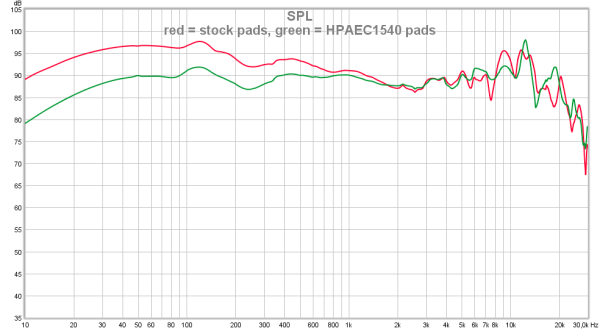
The response now becomes ‘neutral’ and sharpness is slightly better. These luxurious pads also provide excellent comfort and are deeper as well but quite costly.
Bass extension still is 25Hz (-3dB).
The treble response can even be improved (smoothed) a little with some toilet paper between the driver and earpad (more on that further below)
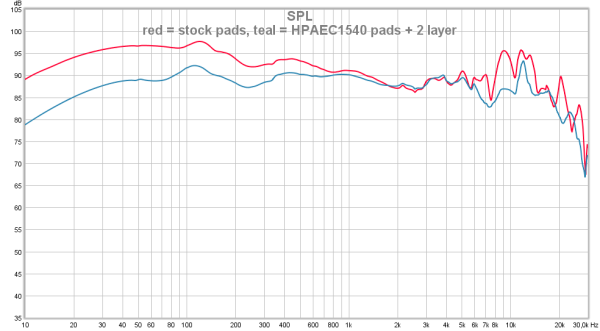 All it takes is a single sheet of 3-ply soft toilet paper cut into shape and with 1-ply of the 3 plies carefully removed so 2 plies remain. The effect differs from 2-ply toilet paper and 2 layers of single-ply toilet paper sheets. Below is what this looks like before the pad is mounted on the SRH-840A.
All it takes is a single sheet of 3-ply soft toilet paper cut into shape and with 1-ply of the 3 plies carefully removed so 2 plies remain. The effect differs from 2-ply toilet paper and 2 layers of single-ply toilet paper sheets. Below is what this looks like before the pad is mounted on the SRH-840A.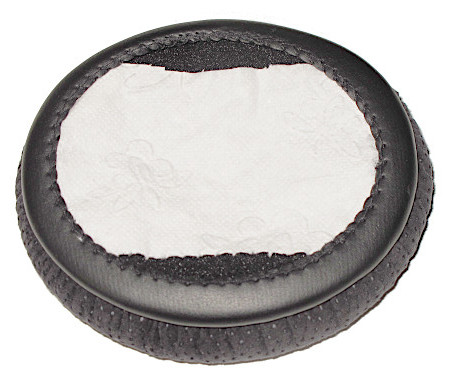
sharpness reduction
The sharpness of the treble (which can easily be mistaken for ‘hyper detail’) can be reduced using EQ, a passive filter but also with materials like toilet paper, paper kitchen towels, coffee filter or felt from crafts stores or those cloth, washable felt-like table wipes.
I can recommend experimenting with those (almost free) materials to see what one prefers.
The materials used here are 3-ply toilet paper and washable felt-like table wipes (thickness around 1 mm).
Below the effect of 2 and 3 plies of a single sheet (cut into shape) of 3-ply toilet paper.
That material can be pulled apart gently leaving you with a 1-ply and 2-ply piece. As 1-ply hardly did anything measurable in this particular case the acoustically smoothed in a 2dB/div plot below shows the effect of 2-ply and 3-ply toilet paper vs no toilet paper (so stock).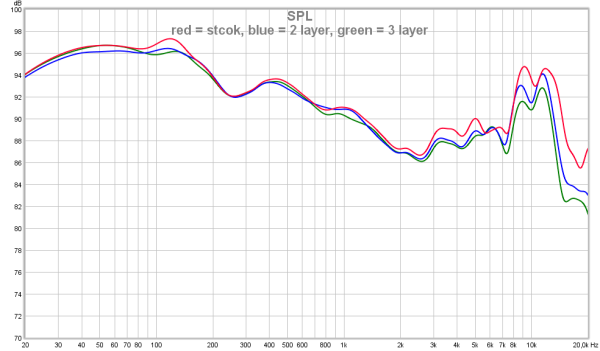
Felt has a slightly different effect. Below a piece of washable (felt-like) table wipes vs stock. 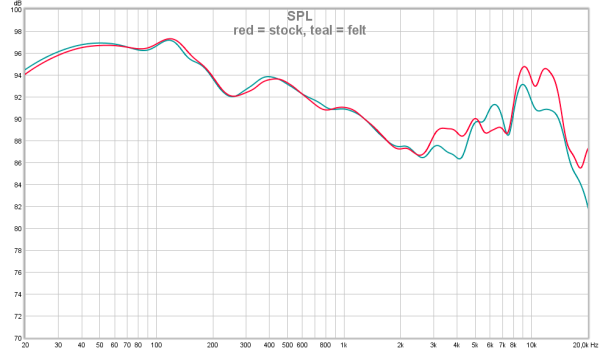
When one likes the tone of the headphone but are bothered by sharpness all one needs is a little bit of toilet paper to cure that (and get smooth treble) which can even easily be tuned to taste.
Not everyone prefers the warmth/bass boost the SRH-840A has.
A passive filter, designed for the OLLO S4X has the right attenuation for this headphone with the stock pads. This lowers the warmth but makes the treble sound a bit sharper due to the relative level between lows and treble peak.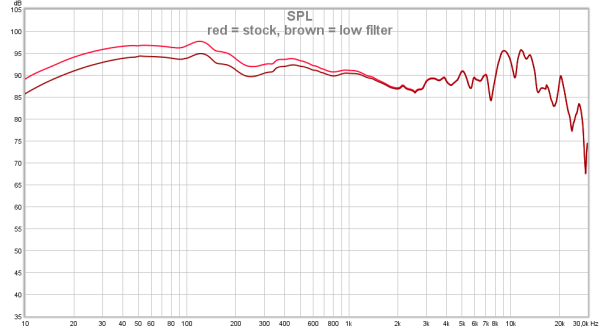
The above described treble reduction method is effective here shaving off just enough of the treble peak so that it still sound detailed but not sharp. In this case the passive low filter + felt gave the proper effect.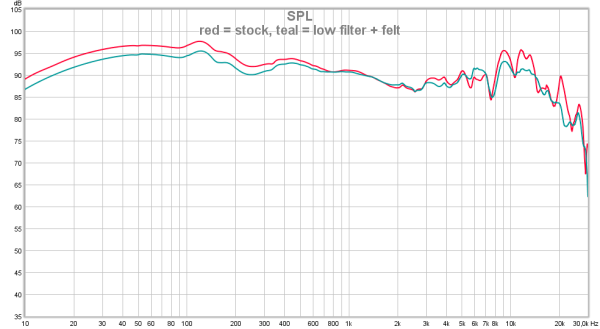
The sound is more neutral and smoother (no sharpness) with just a hint on warmth/bass elevation and the right amount of sparkle.
The difference between the passive filter + felt (when ordering a filter ask me if I include some felt) and the alternative modification (alcantara HPAEC1540 pads + toilet paper) is shown below.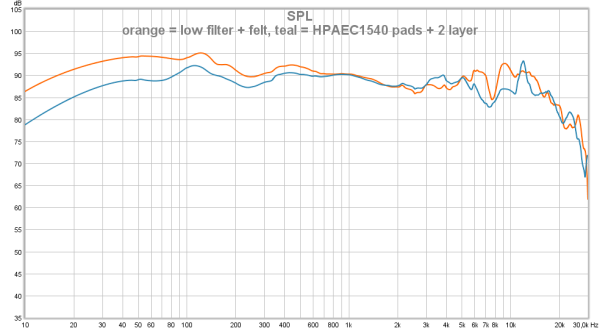 What one prefers will depend on personal preference. In both cases (or when using EQ) the sound quality is an improvement over the stock SRH-840A.
What one prefers will depend on personal preference. In both cases (or when using EQ) the sound quality is an improvement over the stock SRH-840A.
summary
The Shure SRH-840A is an affordable closed headphone with a good sound quality which can easily be improved a bit. It sounds different from its predecessor. Build quality and comfort is good for a closed headphone in this price class. It is well suited for studio usage and home audio music enjoyment.
Isolation is not great for a closed headphone but there is some attenuation of outside noises.
For portable duties it also is well suited and the extra bass/warmth helps here too. Alas the 3m long and microphonic cable are a pain to deal with. A shorter (aftermarket ?) cable would be preferred.
The tonal balance is very good and the sound is dynamic. Comfort is very good as well.
The weight and clamping force is low. The pads are comfortable but will get sweaty due to the pleather and heat isolating memory foam.
The treble is a downside. It is a bit too sharp for music enjoyment. The treble is peaking and needs to be lowered. This can be done with parametric EQ, a passive filter (when digital EQ is not an option) or with some easy and reversible simple ‘modifications’.
Once the treble is lowered the treble quality and overall sound of this headphone sounds very good and is better than some of the competitors at this price point and above.
In the studio these are fine for monitoring. Not suited to mix on because of the elevated bass and sharpness.
A definite improvement over the SRH-840 in comfort, build and sound quality at just a slightly higher price.
